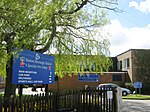Pave Lane
Hamlets in ShropshireTelford and Wrekin

Pave Lane is a hamlet in Shropshire, England, 1.5 miles (2.4 km) south of Newport, just outside the small village of Chetwynd Aston. It is an affluent area, with numerous large houses, many of which have been built in a Duke of Sutherland-inspired architectural style. Residents have excellent views of the Shropshire countryside and are in close proximity to Lilleshall Hall. There is a large public house in Pave Lane; 'The Fox'.
Excerpt from the Wikipedia article Pave Lane (License: CC BY-SA 3.0, Authors, Images).Pave Lane
Pave Lane,
Geographical coordinates (GPS) Address Nearby Places Show on map
Geographical coordinates (GPS)
| Latitude | Longitude |
|---|---|
| N 52.747 ° | E -2.357 ° |
Address
Pave Lane
Pave Lane
TF10 9LF , Chetwynd Aston and Woodcote
England, United Kingdom
Open on Google Maps










